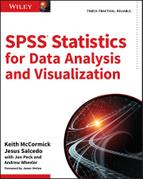Part II
Data Visualization
The length of Part II, encompassing a wide variety of visualization topics in six chapters, is a perhaps a bit of surprise for some readers. When Jesus and I have spoken to clients about custom training engagements, trying to negotiate coverage and the amount of time to dedicate to each topic, the topic of visualization is often among the most difficult to navigate. Clients we have met seem to assume that they’ve got this topic covered, that it is the easiest to master on their own, or that maybe they don’t need this material at all. In short, of all the topics in SPSS Statistics, it is the most commonly deemphasized in a client’s wish list. Visualization is seen as an almost mechanical step—sometimes literally so—where the “results” are copied and pasted into a preexisting format that imitates earlier reports on older versions of the same data. Of course, not everyone is engaged in routine reports that are repeated on a monthly or quarterly basis, but the emphasis on visualization as business communication is common. We believe that visualization is powerful throughout the process of analysis and that one cannot separate the two.
Towards that end, Part II is lengthy and diverse. The first two chapters, numbered 5 and 6, can be thought of as a pair. In Chapter 5, the Graphboard Template Chooser is discussed, and the graphs are produced primarily using the menus. Of all the chapters in the book, it is, perhaps, the one focusing the most on fundamentals. It is important to include, however, because if you are new to graphing in SPSS, Chapter 6 will require some comfort in the graphing menus. Chapter 6 may prove a powerful experience if you dive in and try it. Graphing Production Language (GPL) multiples the power of SPSS graphics by nearly an order of magnitude. It does require coding, so read Chapter 5 first, and consider reading Chapter 16 as well. Chapter 16 is a basic introduction to SPSS Statistics Syntax, so its importance as background for Chapter 6 is determined by your existing comfort with Syntax. Chapter 7 also utilizes Graphboard Template Chooser, but it is dedicated in its entirely to mapping. Since it spends time in some of the same menus, it is not a bad idea to read Chapter 5 before Chapter 7, but those interested in maps can probably start with Chapter 7 without much difficulty. Taken together, they are the most traditional of the chapters in Part II, but even veteran SPSS Statistics users should find a wealth of techniques that are new to them, and that make them both more comfortable and more ambitious in their use of SPSS Statistics graphics.
We are proud that we are able to add Chapter 8, dedicated to geospatial analytics. A major addition to SPSS features in version 23, we wanted a practical application using real world data. Predictive policing is fundamentally about having resources in the right place at the right time. Andrew Wheeler’s expertise in this area was an ideal contribution to the understanding of this approach, and certainly added to our own sophistication with these techniques.
Chapter 9 combines topics from other chapters in a way that is somewhat unique in the book. The notion of perceptual mapping is to use the “data reduction” of rich datasets (with multiple dimensions) to make the data more easily visualized in a two dimensional graphic. Several techniques take advantage of this approach—correspondence analysis is just one of them. Since the focus of the chapter is on the creation and interpretation of the perceptual map itself, the theory behind the data reduction aspect is covered only in brief. The Multiple Correspondence Analysis technique is also used in Chapter 9 to create perceptual maps. Chapter 6 and Chapter 17 should be read first if you are new to the topics. Multidimensional Scaling also uses data reduction to produce perceptual maps. Chapter 10, therefore, continues our discussion, but with more emphasis on theory, and without a discussion of GPL or OMS. Therefore, one can actually read Chapter 10 without reading Chapter 9 first. We believe that the resulting graphics from both Chapters 9 and 10 are testament to one of the themes of Part II—that well executed graphics can be a powerful form of analysis, in and of themselves.
In This Part
- Chapter 5: Take Your Data Visualizations to the Next Level
- Chapter 6: The Code Behind SPSS Graphics: Graphics Production Language
- Chapter 7: Mapping in IBM SPSS Statistics
- Chapter 8: Geospatial Analytics
- Chapter 9: Perceptual Mapping with Correspondence Analysis, GPL, and OMS
- Chapter 10: Display Complex Relationships with Multidimensional Scaling
